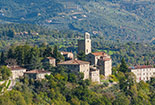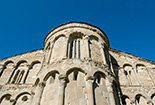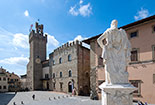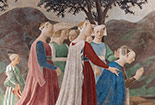The Church of Sietina
in Casentino, a Tuscan valley with which you can get familiar in every detail through this site
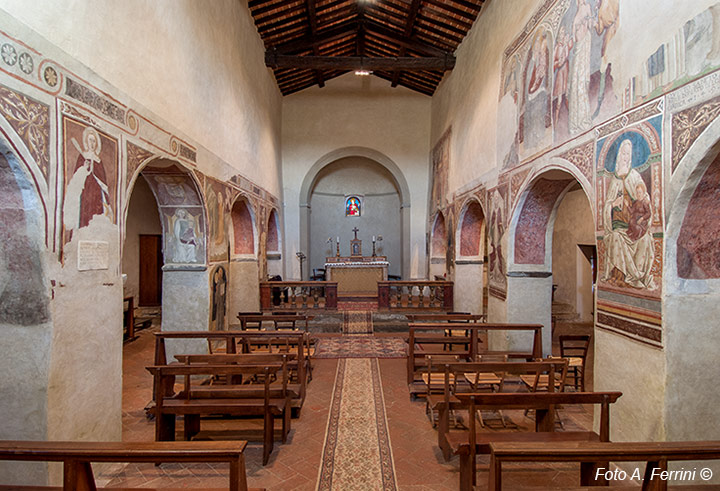
Texts and photos by Alessandro Ferrini ©
36 accurately described images of Pieve of Sietina. Click to enlarge
PIEVE OF SIETINA, a hidden treasure
 Near Castelluccio, alongside the street that from this village leads to Capolona, a couple of indications signal the presence of a church: Pieve in Sietina. A few step away from these crossroads we can find this medieval monument that is worth to visit. Pieve of Sietina is a unique example full of romanic architecture situated in the town of Capolona a few kilometers away from Arezzo and very close to stretch of Arno of which Dante wrote that twists the muzzle of the Aretini.
The holy building is dedicated to Santa Maria Maddalena, of which the image stands out in transparency on the little glass window located in the central apse of Pieve of Sietina that presents a intern architecture of three naves divided by stocky pillars of rectangular section that, besides their structural function act also as a support for fine frescos datable in the second half of the 14 th Century and at the end of 15 th Century.
This fine pictorial opera (an Annunciation an a Baptism of Jesus that are also found on the walls) testimony a important story for this church that had to be sponsored, in order to transfer a modern termin in a medieval poque, surrounded by a rich contest .
All of this seems strange considering the agriculture zone where the church is located, far away from things that could be important in a historical point of view.
To understand this is necessary to make a step back of thousand of years. In that period this zone was called "Campus Leonis" (Field of the Lion) and this name, from which the name Capolona was born, was a synonymous of power and wealth. Near Of Pieve of Sietina arised before the thousand the Castle and powerful Abbey of Campoleone, then destroyed in 1527. In 17th Century the noble and rich Bacci family built on the ruins of the Abbey their sumptuous residence. But this family was dominant on this territory already from some century and these nobles were the major sponsors of Pieve of Sietina.The name Bacci stands out a lot of time next to the frescos of the church and their symbol, with the head of a roaring lion, is located above the mane entrance.
But going back to 11 th Century, period of the edification of Pieve of Sietina, in this zone, along side the right bank of Arno, there was the
Near Castelluccio, alongside the street that from this village leads to Capolona, a couple of indications signal the presence of a church: Pieve in Sietina. A few step away from these crossroads we can find this medieval monument that is worth to visit. Pieve of Sietina is a unique example full of romanic architecture situated in the town of Capolona a few kilometers away from Arezzo and very close to stretch of Arno of which Dante wrote that twists the muzzle of the Aretini.
The holy building is dedicated to Santa Maria Maddalena, of which the image stands out in transparency on the little glass window located in the central apse of Pieve of Sietina that presents a intern architecture of three naves divided by stocky pillars of rectangular section that, besides their structural function act also as a support for fine frescos datable in the second half of the 14 th Century and at the end of 15 th Century.
This fine pictorial opera (an Annunciation an a Baptism of Jesus that are also found on the walls) testimony a important story for this church that had to be sponsored, in order to transfer a modern termin in a medieval poque, surrounded by a rich contest .
All of this seems strange considering the agriculture zone where the church is located, far away from things that could be important in a historical point of view.
To understand this is necessary to make a step back of thousand of years. In that period this zone was called "Campus Leonis" (Field of the Lion) and this name, from which the name Capolona was born, was a synonymous of power and wealth. Near Of Pieve of Sietina arised before the thousand the Castle and powerful Abbey of Campoleone, then destroyed in 1527. In 17th Century the noble and rich Bacci family built on the ruins of the Abbey their sumptuous residence. But this family was dominant on this territory already from some century and these nobles were the major sponsors of Pieve of Sietina.The name Bacci stands out a lot of time next to the frescos of the church and their symbol, with the head of a roaring lion, is located above the mane entrance.
But going back to 11 th Century, period of the edification of Pieve of Sietina, in this zone, along side the right bank of Arno, there was the road that connected Arezzo to Casentino. This road was also known "Via delle Pievi" because along this road there werw the Pieve of San Martino Sopr'arno (today havily transformed), that of Socana, the Pieve of Buiano and the Abbey of Strumi near Poppi, the Pieve of San Martino a Vado in Strada of Casentino and the famous Pieve of Romena (National Monument). This road, from Pieve a Sietina leading to Arezzo, after some kilometers is crossed by Ponte Buriano with the roman Cassia Vetus, the road that connects Arezzo and Fiesole. This road, walked toward Florence location, passed near Pieve of San Quirico (today in ruins) near Castiglion Fibocchi, to the Pieve of San Giustino Valdarno, to the one of Gropina (National monument), to the Badia of Soffena in Castelfranco, to the Pieve of Scò, to the one in Cascia di Reggello and in other less famous. (the trace of Cassia Vetus is nowadays almost marked, from the Strada Setteponti that can accompany in the usual fascinating Valdarno place before mentioned).
The Pieve of Sietina was so located in a rich and powerful zone and near a crossroad of great importance.
The gallery of this section, with it's relative captions made by Valentina Lattari and Alessandro Ferrini, will make you know this Church and all it's peculiarities.
road that connected Arezzo to Casentino. This road was also known "Via delle Pievi" because along this road there werw the Pieve of San Martino Sopr'arno (today havily transformed), that of Socana, the Pieve of Buiano and the Abbey of Strumi near Poppi, the Pieve of San Martino a Vado in Strada of Casentino and the famous Pieve of Romena (National Monument). This road, from Pieve a Sietina leading to Arezzo, after some kilometers is crossed by Ponte Buriano with the roman Cassia Vetus, the road that connects Arezzo and Fiesole. This road, walked toward Florence location, passed near Pieve of San Quirico (today in ruins) near Castiglion Fibocchi, to the Pieve of San Giustino Valdarno, to the one of Gropina (National monument), to the Badia of Soffena in Castelfranco, to the Pieve of Scò, to the one in Cascia di Reggello and in other less famous. (the trace of Cassia Vetus is nowadays almost marked, from the Strada Setteponti that can accompany in the usual fascinating Valdarno place before mentioned).
The Pieve of Sietina was so located in a rich and powerful zone and near a crossroad of great importance.
The gallery of this section, with it's relative captions made by Valentina Lattari and Alessandro Ferrini, will make you know this Church and all it's peculiarities.



